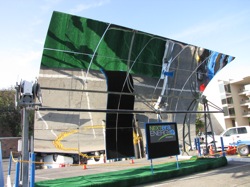
Perhaps the most telling moment at the Governor’s Renewable Energy Policy Conference this week, was when the Governor’s own senior advisor on renewables, Michael Picker, asked for a show of hands. How many present, he wondered, actually thought that California would attain its goal of 33% renewable power by 2020. Amid the 370 or so gathered on the campus of UC Riverside, about a dozen hands went up. How many, he asked, thought we’d make it to 33% by 2050? Another dozen or so hands.
Bear in mind that this was a room containing some of the most knowledgeable people on the topic, from government, industry and environmental organizations. These were people invested in getting there, yet most seemed to doubt that we would.
Their pessimism was not entirely shared by the questioner. Picker told me afterward that he expected about 8,000 megawatts of new power to be approved by year-end. That’s approved, not necessarily financed. Solar arrays that generate 250 MW or more are considered large-scale operations.
Meanwhile, developers are pushing to get major projects approved before the year is out. To qualify for federal stimulus dollars, projects have to break ground this year and spend a certain percentage of project costs.
“It’s a hard state to develop in,” said Matt Handel, a vice president with NextEra Energy Resources. The Florida-based company is already a major player in both solar and wind generation in California, and Handel says the stimulus money is essential for two major new projects that NextEra has in mind for the southern California deserts.
“There is hope,” Handel told me. “It is difficult. There are a lot of constituencies out there pulling in different directions.”
Virtually all of those stakeholder groups were present in Riverside, in some form. Local (especially desert) communities, environmentalists, Indian tribes and representatives from federal agencies such as the Bureau of Land Management and National Park Service were there.
Identifying the most appropriate sites for large-scale wind and solar plants has been complicated by more than bureaucracy, said Kim Delfino, California Program Director for Defenders of Wildlife. “The landscape we’re working in is already changing due to the effects of climate change, which presents a challenge as to which areas to protect,” said Delfino in a panel discussion.
Picker says he’s “not so sure” that the state is doing the best possible job of moving projects efficiently through the pipeline (to borrow a metaphor from the fossil fuels era), and he conceded that some developers will be left standing in line as the year-end deadline expires. But he calculated that if, over the next five years, 20% of the biggest projects on the drawing board can get approved, the state should make its 2020 goal.
4 thoughts on “Hope, Skepticism at Renewables Conference”
Comments are closed.

Good luck to the solar industry using sun energy at the same time the geoengineers are trying to block the sun with aerosol spray grid lines that create a white Frankensky haze lasting all day!!! See californiaskywatch.com for stats on the decreased solar efficiency due to the US gov weather modification spraying!!! Let’s stop the sky pollution, use science for a power renaissance and planet restoration.
And, do you suppose there is a drought in Australia because China is using weather modification and “pulling” the moisture north????
One very new factor that could help ramp up renewables is the innovation of creative financing mechanisms for residential solar installation such as the Sungevity Solar Lease, Power Purchase Agreements (PPAs) and PACE (Property-Assessed Clean Energy) financing available in many parts of CA. It’s really just a question now of letting homeowners know about the availability of these financing mechanisms which allow them to get solar for zero-down and then pay the same or less than they used to pay PG&E for electricity–once homeowners are aware, it’s really a no-brainer.
Thanks for this article.
But are you aware of the geoengineering technique – Solar Radiation Management – which is currently being discussed in Congress and at conferences which promote commercial interests, outside of public scrutiny?
Last week at the Asilomar International Conference on Climate Intervention Technologies (Monterey, CA)they planned to write “guidelines for field-testing” SRM and other techniques.
If you love solar power – or just love the pleasure of sunlight on your back – please take note that there is a plan to haze the sky (globally)with reflective aerosol particles (such as sulfur dioxide or aluminum oxide)and, by doing so, to block sunlight from reaching Earth.
Proponents of SRM assert that this will mitigate global warming.
The Bonnefire Coalition is working to bring public awareness to geoengineering techniques which are being fast-tracked, outside of the legislative process and without public awareness. For more information readers can contact me at bonne_fire@yahoo.com. Also, go to http://www.geoengineeeringwatch.org or search”geoengineering” at http://www.agriculturedefensecoalition.org.
Our scientists seem to have forgotten that we actually need direct sunlight for basic life processes such as photosynthesis and absorption of vitamin D.
Thanks for this opportunity to lend our voice here.
Bonnie Hoag
The Bonnefire Coalition
bonne_fire@yahoo.com